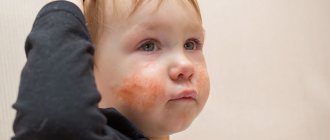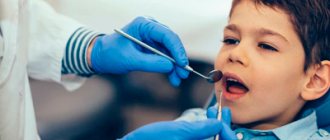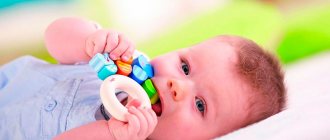How does teeth change?
The rudiments of future permanent units are located under the root of the baby tooth and are separated from it by a thin bone septum. At 6–7 years of age, osteoclasts of the connective tissue surrounding the baby tooth dissolve the mineral component of the septum and destroy it. At the same time, the pulp of the temporary unit is gradually transformed into granulation connective tissue rich in osteoclasts, which gradually destroy the dentin of the primary tooth. At the same time, the roots of the temporary units dissolve and, in fact, only the crown of the baby tooth remains. It can be easily removed on its own, with the help of the dentist’s manipulations, or it can be pushed out by an actively growing molar (permanent) tooth.
Anatomy of permanent teeth The permanent units of a child (and an adult) have a complex anatomy.
Visually, the tooth consists of three parts - crown, neck, roots.
- The crown is the visible part of the tooth that rises above the gum.
- The neck is the part of the tooth at the gum level, in the place where the crown meets the root, and the enamel of the unit turns into cement.
- The root is the part of the unit invisible to the eye, located in the alveolar socket. The base of each unit is made of dentin, a hard tissue. In the coronal part, dentin is covered with enamel, and in the root part there is cement. Inside the dentin is the dental pulp - loose fibrous soft connective tissue, penetrated by a large number of blood and lymphatic vessels and nerve endings. Passing along the root canal, through the apical foramen located on the upper part of the root, they communicate with the main neurovascular bundle, providing nutrition to the tooth, drainage of excess fluid and its innervation.
Normally, by the age of 13, when a permanent bite is formed, a child has 28 permanent teeth. At the age of 17 - 25 years, third molars (wisdom teeth) erupt and the number of units may increase - 32 teeth.
Timing and order of eruption of permanent teeth
Normally, the eruption of permanent units occurs 3 to 4 months after the loss of baby teeth. In girls, this process occurs a little earlier and faster than in boys. In both sexes, the first lower molars appear first. Then the sequence of eruption of permanent teeth is approximately the same as for milk teeth and looks as follows.
- 6 - 7 years - central incisors.
- 7 - 8 years - lateral incisors.
- 9 - 12 years - fangs.
- 10 - 12 years - premolars.
- 10 - 12 years - molars.
The eruption of the second molars completes the formation of the permanent dentition.
After a year, teeth appear with the following frequency:
- by 12-15 months – two pairs of first molars erupt;
- by 18-20 months – a pair of upper and a pair of lower canines are already clearly visible;
- 20-30 months is the period of appearance of two pairs of second molars.
How many teeth should a child have at 1 year 3 months? Ideally 12, but the number can change in one direction or the other, and this is not considered a deviation. The frequency of teething is influenced by many factors, including previous infections, heredity, climate, and health status.
The question of how many teeth a child should have at 1 year 8 months, or 20 months, also cannot be answered unambiguously. The answer will be approximate - about 16. Up to a year, parents should focus on the approximate formula: the number of months minus 4, with a reservation for the baby’s characteristics.
The main differences between baby teeth and permanent teeth
Unlike 28 permanent teeth, the primary dentition requires the presence of 20 units. At the same time, they have a number of characteristic features.
- Smaller in size compared to permanent teeth.
- White with a slightly blue tint (permanent units have a slightly yellowish tint).
- Less developed and slightly short roots compared to permanent teeth.
- The enamel of primary teeth is poorly formed - thinner.
- Milk units can be erased (permanent ones can too, but this is considered a pathology).
As the child grows, baby teeth fall out on their own - this is the norm. The permanent dentition units should not fall out on their own.
What deviations from the norm may there be?
Each child develops individually. Sometimes the timing of the replacement of certain teeth may differ from the generally accepted norm. Minor deviations are allowed up to 12 months. But sometimes the change in the primary bite begins too early or, on the contrary, the temporary teeth do not want to fall out.
Causes:
- long-term breastfeeding;
- severe infectious diseases in infancy;
- pathologies of intrauterine development.
Reference!
Dentists believe that a safer deviation is a late change in the primary occlusion than vice versa.
Let us consider in detail the common violations and their causes.
Early tooth loss
We can talk about such a pathology if a child’s baby teeth begin to fall out before the age of 5. Possible reasons:
- advanced multiple caries;
- injury;
- gum disease;
- manual loosening of the tooth.
In all these cases, consultation with a pediatric dentist is required.
Important!
Parents should record the time of tooth loss. If after 4 months the permanent tooth does not begin to emerge, then the help of a doctor is required.
In case of early unnatural tooth loss, it is advisable to conduct an X-ray diagnosis. This will help to identify possible damage to the permanent root rudiment in time and begin treatment. Otherwise, the child will need prosthetics in the future.
Late change from primary to permanent occlusion
The deadline for starting the process of changing baby teeth is 8 years. But this is considered a late shift. The disorder may be caused by:
- heredity;
- metabolic disorders;
- infectious diseases suffered in early childhood;
- mental disorders.
If after 8 years a child has not lost a single baby tooth, this is a reason to consult a doctor.
How to determine that a child will soon have molars?
An increase in jaw size is the main sign of a future change of teeth. Visually this may not be noticeable. But the appearance of three and diastema (gaps) between the baby teeth indicates that the child’s jaw is growing and preparing for the formation of a permanent bite.
The following signs are purely individual - they may or may not be present in the child.
- Increased salivation.
- Redness, swelling of the gums and oral mucosa.
- Sore gums.
- Unpleasant itching of the gums.
- Increased body temperature.
- Unreasonable cough, runny nose.
- Stool disorder.
- General malaise, lethargy.
- Loss of appetite.
- Sleep disturbance or, on the contrary, drowsiness.
- Anxiety, irritation, whims.
Important! During the period of permanent teeth erupting, parents should monitor the condition of the child, the oral cavity and gums. If symptoms that cause concern appear, you should immediately consult a doctor - a pediatrician or pediatric dentist.
When should you start brushing your child's teeth?
Now pediatric dentists are inclined to believe that systematic cleansing of a child’s oral cavity should begin... from the first days of his life. After feeding, you need to take clean gauze or a bandage, wrap it around your finger, moisten it with boiled water and rub it over the newborn’s gums. This is how you can avoid such major troubles as, for example, oral candidiasis (thrush).
Cleaning the first teeth can be done with a cotton swab or fingertip. You should start using toothpaste and brushing at 12-14 months. Almost all children's brushes are now made from soft artificial bristles, but still be careful and check the brush you like: what age it is designed for, and whether it is soft enough. Give preference to products from well-known manufacturers. Toothpaste also differs in composition and taste depending on the age of the children for whom it is intended. The child should be explained that toothpaste should be spat out, even though it is sweet. However, keep in mind: nothing bad will happen if a child swallows a certain amount of paste at first: manufacturers are aware of this tendency of children and make children's pastes safe for the body.
Of course, it is necessary to involve the child in the dental care process as much as possible: show how to use a brush correctly, brush your teeth in the presence of the child, thereby demonstrating how important this procedure is. You can involve your baby in the process of choosing toothpaste and brush, especially since the brush needs to be changed every 3 months. A slightly older child can be asked to choose brushes for the whole family. It is necessary to develop in your child the skill of regular brushing of teeth 2 times a day. More attention should be paid to brushing your teeth at night. And yet, you can let go of the situation and leave the child to his own devices in matters of oral hygiene only when the child turns 10 years old.
Possible problems
Despite the fact that changing teeth is a natural physiological process, some children and their parents may encounter a number of problems that require contacting a pediatric dentist.
No molars
The absence of permanent units can be caused by congenital edentia - the complete or partial absence of tooth buds.
Another reason for the absence of molars is previous inflammatory diseases - periostitis or periodontitis, resulting from progressive caries. Inflammatory diseases of the periosteum and periodontal tissues have an extremely negative effect on the condition of the tooth buds and can lead to their death.
Important! It is absolutely necessary to treat baby teeth for caries. You should not assume that the problem will go away on its own with the change of teeth. The progression of the disease can negatively affect the health of the tooth buds.
Molar tooth hurts
The enamel of newly emerging permanent teeth is still poorly formed. The low level of its mineralization makes teeth vulnerable to cariogenic microflora. This can lead to the development of caries and cause pain.
Due to poorly formed enamel, tooth sensitivity to external irritants (cold, hot, sour, sweet) may increase, which is also accompanied by painful sensations.
Important! Normally, permanent teeth do not hurt. If pain occurs, you should contact your pediatric dentist. The specialist will determine the cause of the pain, carry out the necessary treatment, fluoridation or remineralization of tooth enamel.
Molars grow crooked
The incorrect position of permanent teeth can be caused by two reasons - the growth of the permanent unit outpaces the process of loss of baby teeth or they were removed ahead of schedule, which led to incorrect formation of the rudiments of permanent teeth.
In this case, there is only one way out - orthodontic treatment of malocclusion.
Important! A malocclusion must be corrected. The sooner you contact a dentist, the more successful the treatment will be. The child will be prescribed to wear removable or fixed orthodontic appliances that will help straighten the permanent teeth and bite.
Injuries
Due to their activity and lack of experience, children can accidentally injure a newly emerging permanent tooth. Due to mechanical damage, cracks and chips may appear on it. The damage looks unattractive. Caring for such teeth is complicated, since food debris can get stuck in the cracks, which will certainly lead to the development of caries.
Important! If a child accidentally injures a permanent tooth, it is necessary to seek help from a dentist. The specialist will assess the complexity and depth of the damage and will build up the missing volume of tooth tissue with composite materials.
Tooth loss
Loss of healthy permanent teeth can only occur as a result of severe trauma to the jaw, for example, during a child’s fall or fight. A diseased molar may fall out on its own. In this case, you will also need to consult a specialist. Most likely, the child will undergo temporary prosthetics for the lost unit, which will not disrupt the formation of a correct permanent bite.
The tooth is loose
Looseness of a permanent tooth is an alarming symptom indicating a pathology of the dentofacial apparatus or the presence of inflammation. Consultation with a specialist is required!
Problems that arise during teething in children
During the teething process you may encounter the following problems:
- Late or early appearance.
Most often, early teething can occur with the lower central incisors. Sometimes a child may already be born with them.
Late teething is possible due to poor nutrition of the child, as well as past illnesses and concomitant chronic pathologies.
- Violation of the order and pairing of teeth eruption.
It is also possible that one or more teeth are missing from the dentition. This situation is possible due to the death of the embryos during the prenatal period of the baby’s development.
- Increase in temperature during teething.









